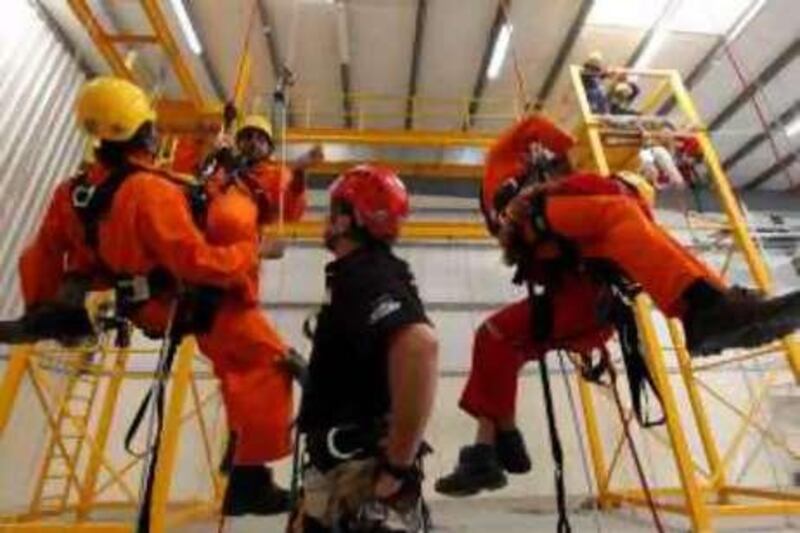DUBAI // Suspended four metres below a railing high above the ground, Kishan Lal attempts a risky rescue of an unconscious co-worker. His instructor, James Falchetto, lets him know the stakes: "If you fall from there, the pressures liquifies your internal organs. It's like having a car accident with a single belt across your stomach; your spleen will rupture and your kidneys will burst. Unless you are 15 minutes away from the world's best trauma centre, you're finished."
Carefully, Mr Lal descends another two metres to level himself with his co-worker. He transfers the man to his rope and locks him in with a carabiner. It's only a training exercise for those who one day could be working on some of the world's tallest buildings, including cleaning the cladding and windows of the Burj Khalifa, but the students approach it with a deadly seriousness. The class is being conducted at the Industrial Rope Access Trade Association, a new training centre at the Dubai Investment Park that opened this month by Traks Pro, which has a long history of training UAE rescue teams. The facility is equipped with the first nine-metre indoor training rig in the region.
"We always had to train them outside but here it is in a controlled environment," says Mr Falchetto of Traks Pro. "It is not that high but they can learn what to do and then replicate it out on the job. For the past few years so many towers were built in Dubai, somebody had to maintain and clean them. "The victim can be stuck on a set of ropes or a lanyard and we expect him to pick them off the ropes. It is a simple procedure. You just hook the guy in a certain way and he is attached to your equipment."
Mr Lal, a 24-year-old Nepali who works for a building maintenance company called Gecko, hopes to be certified to clean the windows on the Burj Khalifa. "He managed to lift him and attach him in seconds," says John Wisse, the training manager, evaluating Mr Lal's performance. "These guys really have what it takes." But Mr Falcetto spots a potential problem: Mr Lal is a shade lower on his rope than the victim. "There's potential of him falling over. In rope access we never fall."
Mr Lal, who is training for his level one certificate, notices the problem and climbs a little higher up the rope. As part of his training he is required to know his equipment and be responsible for it at all times. The first-level students learn to inspect their harnesses, carabiners and ropes for any defects every time they are used. Even a hairline fracture in the carabiner could cause it to snap, sending them straight to the ground from dozens of storeys up. In level two, trainees rig their own ropes.
Traks Pro also trains the Dubai Police Rescue, Dubai Civil Defence and Abu Dhabi Police in rope rescues, as well as the Ras al Khaimah Airwings, who, with the aid of helicopters, rescue people from mountains during the winter. Prem Jith, a 28-year-old structural inspector on oil rigs off Nigeria's coast, is training for his level three certificate, which requires him to be able to set up a level-one worker and supervise level one and two training.
His company, Emirates Industrial Laboratories, inspects bridges, oil rigs and other man-made structures in hard-to-reach places. As part of his training, he starts instructing two teams, one on the ground and the other on top of the rig, as they lower a mannequin. The "victim" has to land safely, gently and horizontally. "What angle is he supposed to be at?" shouts Mr Falchetto at Mr Jith. The mannequin is dangling upright, instead of flat.
"They have to get this right. He is responsible for the entire team at all times," Mr Falchetto says. Mr Jith shouts orders at the ground team, who are pulling two sets of ropes. Meanwhile, another team at the top of the rig slowly feeds rope to the team below. After several minutes, the mannequin finally makes a gentle, flat landing. Mr Lal says he hopes never to have to put his new rescue skills into practice in Dubai, where he plans to stay for five years or so.
After that, he says he will return to Nepal, to join rescue squads on the Himalayas. "It would be good to go home in a few years and get the additional skills to work in the search and rescue," says Mr Lal. "Between now and then, I've a lot to learn." eharnan@thenational.ae






